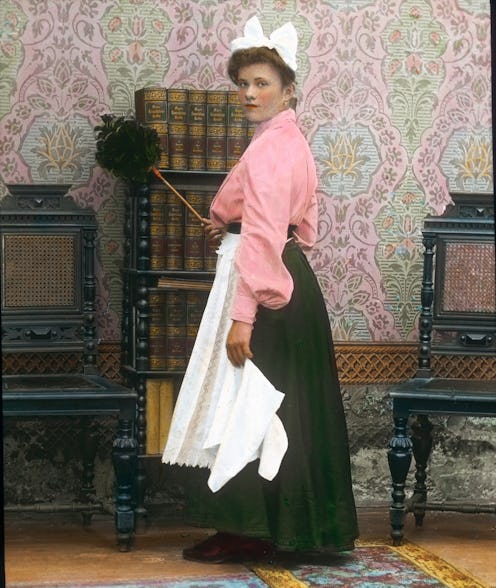Lifestyle
Experts Say You've Been Cleaning Your Wallpaper All Wrong
Plus, 4 other historic cleaning tips from English Heritage that will blow your mind.

It’s about that time when the urge to spring clean your entire home becomes top of the ever-growing to-do list. Whilst the internet is full of modern cleaning tips and hacks, why not try some ye olde techniques to help leave your space (somewhat) sparkling. For Spring, English Heritage has revealed some of its wildest cleaning tips including some pretty unusual uses for white bread and milk.
From using bread to clean wallpaper to using skimmed milk to clean stone floors, the charity has tried and tested some of the best back-to-basics historical cleaning tips that can actually be replicated today. And, according to English Heritage, a lot of housekeepers of the past were “spot on with their methods” although, they recommend proceeding to your kitchen cabinets with caution. For one thing, they advise against using Worcestershire sauce to polish silver.
Amber Xavier-Rowe, head of collections conservation at English Heritage, explained: “Although we may not recommend some of the more bizarre tips, housekeepers of the past were often spot-on with their methods, despite relatively little scientific knowledge.”
English Heritage has released a how-to video via their Youtube channel, starring Kathy Hipperson who portrays Victorian domestic servant Avis Crocombe. Turns out, washing up the Victorian way is pretty innovative.
Use bread to clean wallpaper
I am a bit dubious about this tip, but apparently wiping mucky wallpaper with white bread is “surprisingly effective”– although it does leave more than few crumbs.
“It does work, although it does need to be fresh white bread – stale bread would be too abrasive. I tried it with some of my sourdough and it was surprisingly effective. It’s very gentle,” says Xavier-Rowe. “You do get crumbs so it’s not super-practical for us, to be honest. But if you can’t get hold of the stuff we use then it’s perfectly fine. You’ve just got to vacuum your crumbs up.”
Use skimmed milk on stone flagstone floors
Another technique with surprisingly great results. “We tried full fat, semi-fat, we were pretty methodical about it. The full fat and semi-fat milk produce a blotchy appearance because of the fat,” said Xavier-Rowe to The Telegraph. “But the skimmed milk, you just wipe it on then you leave it and it gives a really subtle, nice finish.”
They recommend testing a small area first and also assure that “it doesn’t smell.”
Try beeswax and turpentine for timber floors
Give your timber floors a new lease of life with a good polish using beeswax and turpentine. It’s a popular method still used quite regularly today and beeswax is said to protect and seal wooden surfaces. And it smells good, too.
Use a pony haired brush to dust your furniture and figurines
A great tip for those with animals who shed a lot (or if you, in fact, are the hairy culprit) is to use a pony-haired brush to dust down your furniture. The bristles are usually said to be tough on dirt and stains, but gentle on upholstery.
Use a soft chamois leather to give a shine to mirrors
Instead of using heavy-duty glass cleaners, English Heritage recommends using soft chamois leather to give your mirrors a great shine. It’s reusable and produces less chemical waste, they say.